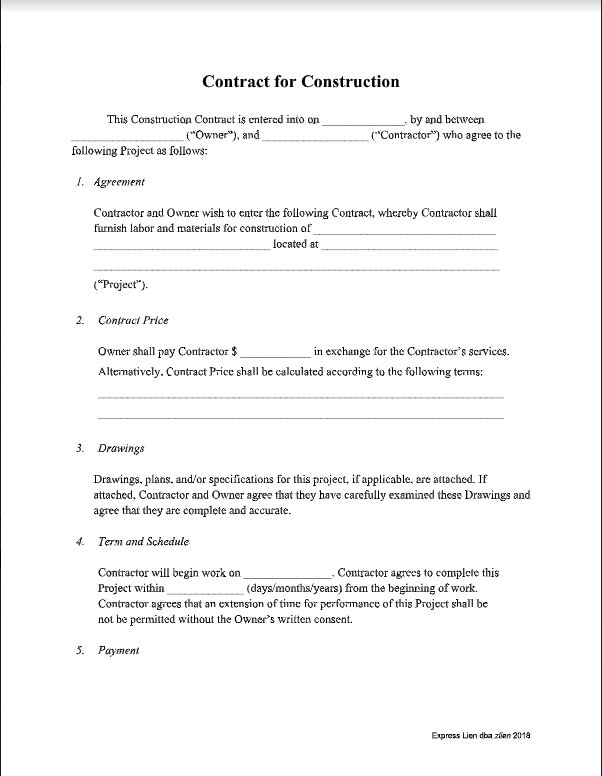Construction agreements do not have to be long, complicated documents. This simple construction contract template is a total of 3 pages! Using a simple contract like this one is always better than no contract at all. This contract template is available in Microsoft Word format, so you can easily customize the agreement with the terms or clauses that your project requires.
What this contract template includes
This simple construction contract template contains the most common clauses used in the industry, written in simple language that is easy for both parties to understand.
- Definitions: Defines the Owner and Contractor
- Scope of Agreement: Location of the project and the basic work to be performed
- Contract Price: The amount to be paid
- Drawings: States that
- Term & Schedule: The timeframe for the work to be completed
- Payment: How and when contractor payments will be made during the project
- Permits & Licensing: Sets requirements and obligations for both sides
- Subcontractors: Holds the contractor liable for any subcontractors they hire on the project
- Materials & Equipment: Puts purchasing responsibility on the contractor
- Job Site: Sets contractor expectations for cleanliness upon project completion
- Change Orders: Requires change order approval before any changes to the scope of work
- Termination clauses: When each side has the right to terminate the contract
- Severability: Makes any clause void if it is found invalid or unenforceable
5 steps to a successful construction contract
1. Be clear
Customize the construction contract template with clear language that specifies the rights and responsibilities of each party to the agreement.
2. Be specific
Vague contract terms lead to construction disputes. Make sure that your agreement provides an adequate level of detail so that each party knows exactly what they need to do to complete the project successfully.
3. Include
3. Include supporting documents
The construction agreement is just one of several important contract documents. This construction contract template includes sections for simple descriptions of each part of the agreement. Depending on the size and complexity of your building project, your contract may contain other documents, including:
4. Watch out for problem clauses
Some construction contracts contain clauses that shift risk too heavily onto one party. Here are some of the most problematic contract clauses to keep an eye out for:
5. Get it in writing
A written contract signed by both parties is always better than a verbal contract or a simple handshake deal. Other important items such as change orders should be in writing, too.
The construction business is built on relationships, and the industry has historically relied heavily on handshake deals. When new business comes in, it’s usually not from advertising or other formal business development efforts, but rather from referrals and word of mouth — especially for the small-to-medium construction outfits that are the backbone of the entire industry.
Because of this inherent familiarity, there’s a tendency to overlook some of the formalities that often accompany many business deals. And one of those overlooked formalities is to get it in writing by using a construction contract.
Contracts protect everyone on a construction project
Property owners want to hire contractors that they can trust to get the job done and avoid disputes. Contractors want to get paid on time and complete the job to the owner’s satisfaction. A well-written contract sets expectations for both sides to ensure that everyone is on the same page.

